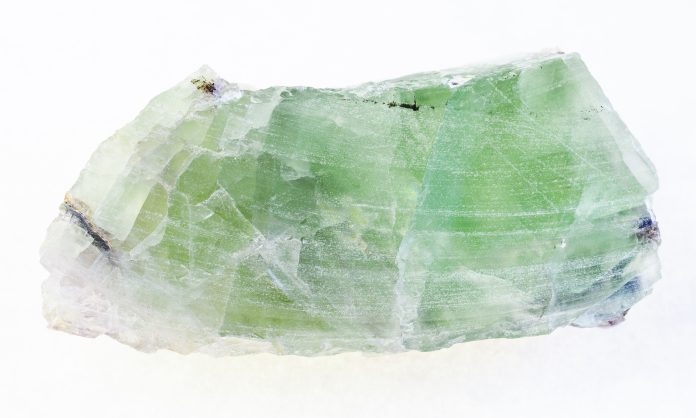
Green rocks vary in rarity, cost, durability and shine, plus the color green is often associated with good luck, money and health. Whether you wear green gemstones to honor your Irish heritage or to enjoy some of Mother Nature’s finest work, there are green rocks for you. Experts weigh in on their favorite green rocks and why you should be envious if they’re not in your rock collection yet.
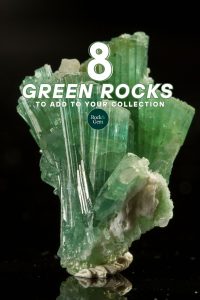
1. Emerald
Perhaps the most well-known of the green rocks and gems, emeralds have enthralled admirers since pre-historic times. It’s a member of the beryl family, which also consists of aquamarine, bixbite, goshenite, heliodor and morganite.
While they’re mined in Brazil, Zambia and Ethiopia, Colombian emeralds make up 70 to 90 percent of the world’s market. For gemologist Joshua M. Hyman, G.G. (GIA), the Colombian variety has the finest specimens. He’s a fourth-generation Philadelphia jeweler and appraiser. “The best ones have always been found in Colombia — just outside of Bogotá,” he said.
Emeralds are rare because of their chemical makeup. They form when chromium, vanadium, and iron are present in the mineral beryl. Ranging from a 7.5 to 8 on the Mohs scale, these green rocks are ideal for everyday wear. Most emeralds have inclusions, making “eye-clean” specimens particularly valuable.
2. Green Beryl
While all emeralds are beryl, not all green beryl gemstones get classified as emeralds.
“As a gemologist, you know the difference when you see it,” Hyman noted. “Green beryl looks like an aquamarine, but it’s green. It’s very clean and pastel in color hue. It’s got more of a yellow-green component, whereas emerald is more heavily included. Some people say it’s a saturation level. Some say it’s a trace element discussion. Lack of either chromium or vanadium, but green in color, makes it green beryl.”
Third-generation jeweler Staci Sullivan, based in Melbourne, Florida, said she likes to regard green beryl as if “aquamarine and emerald had a baby.” Sullivan graduated from the Gemological Institute of America (GIA) with a Diamond Graduate degree.
“Beryl looks like the water in the Bahamas, which is soothing to me. I could look at it forever,” Sullivan said.
While green beryl has the same Mohs hardness as emeralds, there can be slight variations when it comes to durability. “Typically the more minty ones have fewer inclusions than emeralds. The more inclusions the stone has, the more fragile it is,” she added.
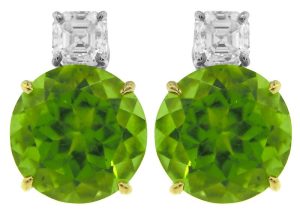
Photo courtesy Joshua M. Hyman
3. Peridot
The gem variety of the mineral olivine, peridot is always found in some shade of green. While almost all gemstones form in the Earth’s crust, only diamonds and peridot form in the mantle.
“Peridot is my favorite stone after emeralds. It’s extremely double refracted. When you look at it with a loop, inside all the facet junctions are doubled. It’s very similar to zircon,” Hyman noted.
High-quality peridot rivals the beauty of rarer stones. Don’t let its affordability fool you.
“Peridot in America has a bad rap because so much of it is found in Arizona in bulk and it’s very light in color, used in inexpensive jewelry like from department stores, mothers’ jewelry, birthstone jewelry, etc,” he said.
High-quality stones can be found in Burma and Pakistan. “Burmese peridot can resemble fine green tourmaline or even fine emerald,” Hyman said. “And it’s affordable. It’s hard and durable. It’s very clean inside.” He noted fine peridot sells for $500 to $1,000 a carat — a dramatic savings in cost compared to emeralds, which can command $50,000 a carat.
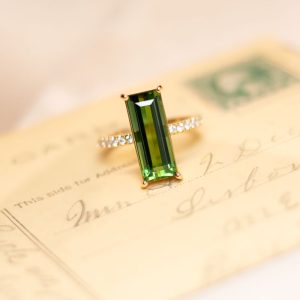
Photo courtesy Julie Walton Garland
4. Green Tourmaline
Also known as verdelite, the name comes from the Latin “viridis” meaning green, and the Greek suffix “lith” meaning stone. Green tourmaline is primarily mined in Brazil, Namibia, Nigeria, Mozambique and in the mountains of Pakistan and Afghanistan.
“It can be really dark and super-saturated,” Hyman said. “It can be very light and minty, too. The range of colors and saturations and tones for green tourmaline is the entire palette of the color green. Go to a paint store, look at the color green section, all those colors exist in green tourmaline.”
Hyman suggests purchasing the varieties from Brazil and Nigeria for maximum quality assurance.
“If you look at a map, and you see where those two countries sit, you can do the reverse continental shifting, and they match up like a puzzle. They share a lot of the same gem deposits,” he noted. “The finest green tourmaline I’ve ever seen is from Paraíba, which is a state in Brazil. Green tourmaline from that mine can sell for similar prices to diamonds.”
Green tourmaline is a 7 to 7.5 on the Mohs scale, with its toughness classified as “fair.” These green rocks can be damaged by heat and scratch easily.
“But because it’s soft, it’s easily fixed and polished. It can be repaired easily. There is very little risk of breakage, but there’s a higher risk of scratching,” Hyman explained.
Tourmaline comes in every shade in the rainbow, making it a more affordable alternative to fancy diamonds.
“Tourmaline is very popular. It seems like a stone people are really receptive to,” Sullivan said. “Depending on the shade they’re looking for, it has a lot of variety.”

Photo courtesy Joshua M. Hyman
5. Tsavorite Garnet
Tsavorite is a green gem variety of grossular garnet. It was first found in 1967 in northern Tanzania and again in 1970 in Kenya’s Tsavo National Park by noted geologist Campbell Bridges. These green rocks received a prestigious boost when Tiffany & Co. began using them in its jewelry, starting in the mid-70s. It continues to be mined in a remote bushland that’s home to lions and volcanoes.
“It’s a very often looked over stone because it’s a garnet, and most people associate garnet with the inexpensive red variety,” Hyman noted. “But these green tsavorites in larger sizes are extremely rare and extremely beautiful, and are just as hard, or harder, than emerald.”
Tsavorite garnet ranks 7 to a 7.5 for Mohs hardness. You’re unlikely to find tsavorites in sizes that are larger than 2.5 carats.
“The color that’s been popular lately in the market is a minty color tsavorite. There’s an area called Merelani in Tanzania where they’re found,” he said.
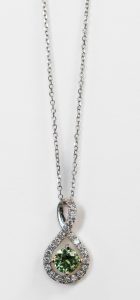
Photo courtesy Staci Sullivan
6. Demantoid Garnet
Demantoid garnet is the Tsavorite garnet’s slightly flashier cousin. It’s a green andradite, which is softer than grossular, but has a higher refractive index and higher dispersion. Demantoids can cost 30 percent more than tsavorites.
“Demantoids have flashes of yellow and orange. They have a lot of refractive index that gives them kind of a fireworks going off inside it look,” Sullivan explained. “You mostly think of (white) diamonds as very refractive, so it’s nice to see a colored stone that has that capability as well.”
Demantoid was first found in 1868 in Russia’s western central Ural Mountains. Its name comes from the old German word “demant” meaning diamond, as the stone was favorably compared to diamonds. Its green hue rivals emeralds and its brilliance and dispersion give diamonds a run for the money.
“Sometimes you’ll see a faceted demantoid garnet that has a simulation of a rainbow, which is cool to see,” Hyman said.
Demantoids can contain unique needle-like byssolite fiber inclusions that give a horsetail-like appearance.
“They’re usually an Irish lime green in color, sometimes hunter green, but they have high dispersion — higher dispersion than diamond,” he noted.
Demantoid garnet is mined in Canada, Iran, Namibia, Pakistan, Italy and Madagascar, but the Russian variety continues to impress gemologists.
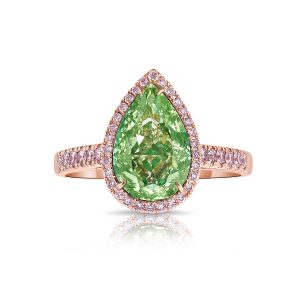
Photo courtesy Namdar Diamonds
7. Green Diamond
Natural green diamonds are the second rarest variety after red diamonds. They entered the public consciousness after Ben Affleck presented Jennifer Lopez with one as an engagement ring.
“Green diamonds get their color through irradiation. They’ve been near radioactive material at some point. They start as a white or yellow diamond that was near radiation. This can take a million years,” Hyman explained.
Green diamonds sold on the market today for mass distribution in stores and online shopping platforms have been color-enhanced.
“Man has learned we can use our nuclear reactors to irradiate natural diamonds to make them green,” he said. “The laboratories can’t differentiate between when man does it and when the earth did it. It’s very rare to find a natural green diamond, versus a treated one. The only way the lab can tell is to see if some of the natural skin is still on the green diamond. It will have indications of whether it was natural or treated. If the skin has been polished off, the labs can’t tell.”
8. Chrome Diopside
Easily the underdog of green rocks, chrome diopside gets its color from chromium, the same element that makes emeralds green. The stone in gem-quality form is primarily found in the remote mountains of Siberia. It grew in popularity on the market in the late 1980s, earning the nickname “Russian Emerald.”
“It’s a very deeply saturated green. Sometimes it appears black,” he said. “It’s very much considered a semi-precious stone. I’ve never seen it set in a designer piece. It’s more of a TV station stone sold on home shopping networks.”
While it’s only a 5.5 to 6.5 on the Mohs scale, it can be worn every day with regular cleaning and professional examinations for damage and avoidance of strenuous activity when wearing.
“Chrome diopside is more cost-effective than other stones, but it gives you a richness that has a more authentic green than if you got a lab-grown stone,” Sullivan explained.
This story about eight green rocks to collect appeared in Rock & Gem magazine. Click here to subscribe. Story by Sara Jordan-Heintz.















